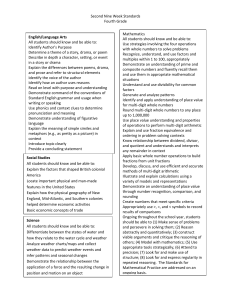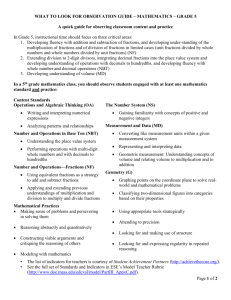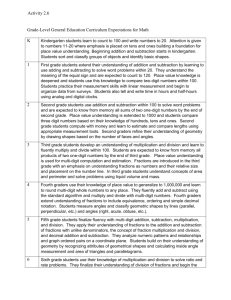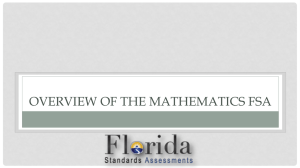Common Core State Standards - Mathematics Content Emphases
advertisement
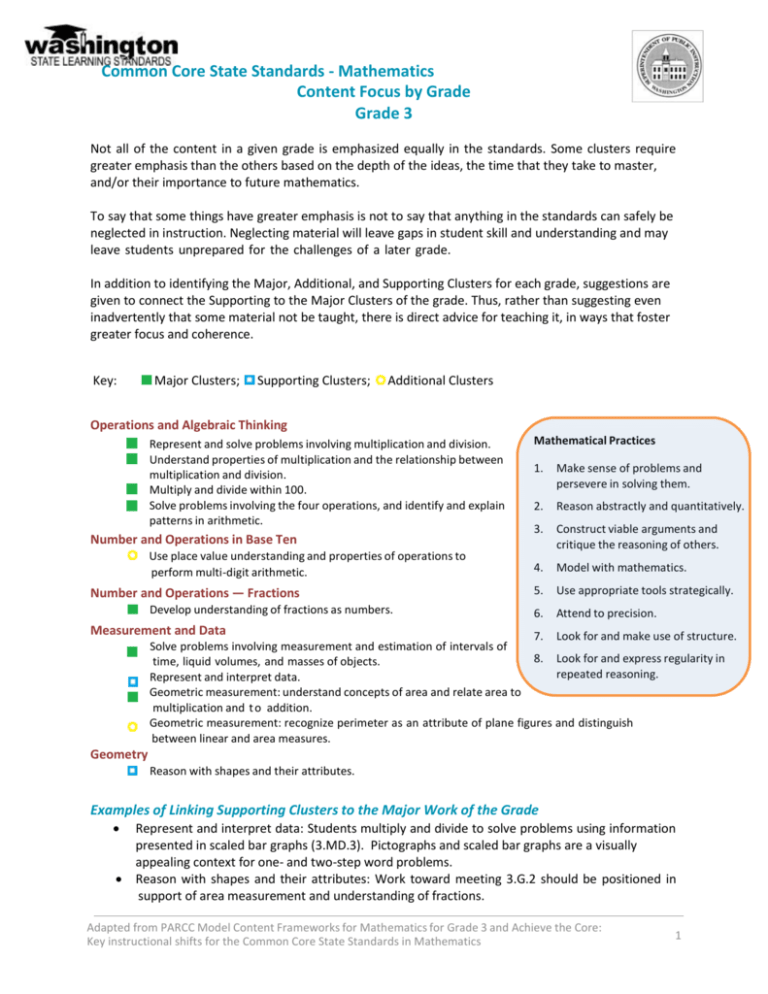
Common Core State Standards - Mathematics Content Focus by Grade Grade 3 Not all of the content in a given grade is emphasized equally in the standards. Some clusters require greater emphasis than the others based on the depth of the ideas, the time that they take to master, and/or their importance to future mathematics. To say that some things have greater emphasis is not to say that anything in the standards can safely be neglected in instruction. Neglecting material will leave gaps in student skill and understanding and may leave students unprepared for the challenges of a later grade. In addition to identifying the Major, Additional, and Supporting Clusters for each grade, suggestions are given to connect the Supporting to the Major Clusters of the grade. Thus, rather than suggesting even inadvertently that some material not be taught, there is direct advice for teaching it, in ways that foster greater focus and coherence. Key: Major Clusters; Supporting Clusters; Additional Clusters Operations and Algebraic Thinking Represent and solve problems involving multiplication and division. Understand properties of multiplication and the relationship between multiplication and division. Multiply and divide within 100. Solve problems involving the four operations, and identify and explain patterns in arithmetic. Number and Operations in Base Ten Use place value understanding and properties of operations to perform multi-digit arithmetic. Number and Operations — Fractions Develop understanding of fractions as numbers. Mathematical Practices 1. Make sense of problems and persevere in solving them. 2. Reason abstractly and quantitatively. 3. Construct viable arguments and critique the reasoning of others. 4. Model with mathematics. 5. Use appropriate tools strategically. 6. Attend to precision. Measurement and Data 7. Look for and make use of structure. Solve problems involving measurement and estimation of intervals of 8. Look for and express regularity in time, liquid volumes, and masses of objects. repeated reasoning. Represent and interpret data. Geometric measurement: understand concepts of area and relate area to multiplication and t o addition. Geometric measurement: recognize perimeter as an attribute of plane figures and distinguish between linear and area measures. Geometry Reason with shapes and their attributes. Examples of Linking Supporting Clusters to the Major Work of the Grade Represent and interpret data: Students multiply and divide to solve problems using information presented in scaled bar graphs (3.MD.3). Pictographs and scaled bar graphs are a visually appealing context for one- and two-step word problems. Reason with shapes and their attributes: Work toward meeting 3.G.2 should be positioned in support of area measurement and understanding of fractions. Adapted from PARCC Model Content Frameworks for Mathematics for Grade 3 and Achieve the Core: Key instructional shifts for the Common Core State Standards in Mathematics 1 Common Core State Standards - Mathematics Content Focus by Grade Grade 4 Key: Major Clusters; Supporting Clusters; Additional Clusters Operations and Algebraic Thinking Use the four operations with whole numbers to solve problems. Gain familiarity with factors and multiples. Generate and analyze patterns. Number and Operations in Base Ten Generalize place value understanding for multi-digit whole numbers. Use place value understanding and properties of operations to perform multi-digit arithmetic. Number and Operations — Fractions Extend understanding of fraction equivalence and ordering. Build fractions from unit fractions by applying and extending previous understandings of operations on whole numbers. Understand decimal notation for fractions, and compare decimal fractions. Measurement and Data Solve problems involving measurement and conversion of measurements from a larger unit to a smaller unit. Represent and interpret data. Geometric measurement: understand concepts of angle and measure angles. Mathematical Practices 1. Make sense of problems and persevere in solving them. 2. Reason abstractly and quantitatively. 3. Construct viable arguments and critique the reasoning of others. 4. Model with mathematics. 5. Use appropriate tools strategically. 6. Attend to precision. 7. Look for and make use of structure. 8. Look for and express regularity in repeated reasoning. Geometry Draw and identify lines and angles, and classify shapes by properties of their lines and angles. Examples of Linking Supporting Clusters to the Major Work of the Grade Gain familiarity with factors and multiples: Work in this cluster supports students’ work with multi-digit arithmetic as well as their work with fraction equivalence. Represent and interpret data: The standard in this cluster requires students to use a line plot to display measurements in fractions of a unit and to solve problems involving addition and subtraction of fractions, connecting it directly to the Number and Operations — Fractions clusters. Adapted from PARCC Model Content Frameworks for Mathematics for Grade 4 and Achieve the Core: Key instructional shifts for the Common Core State Standards in Mathematics 2 Common Core State Standards - Mathematics Content Focus by Grade Grade 5 Key: Major Clusters; Supporting Clusters; Additional Clusters Operations and Algebraic Thinking Write and interpret numerical expressions. Analyze patterns and relationships. Mathematical Practices 1. Make sense of problems and persevere in solving them. 2. Reason abstractly and quantitatively. 3. Construct viable arguments and critique the reasoning of others. 4. Model with mathematics. 5. Use appropriate tools strategically. 6. Attend to precision. 7. Look for and make use of structure. 8. Look for and express regularity in repeated reasoning. Number and Operations in Base Ten Understand the place value system. Perform operations with multi-digit whole numbers and with decimals to hundredths. Number and Operations — Fractions Use equivalent fractions as a strategy to add and subtract fractions. Apply and extend previous understandings of multiplication and division to multiply and divide fractions. Measurement and Data Convert like measurement units within a given measurement system. Represent and interpret data. Geometric measurement: understand concepts of volume and relate volume to multiplication and to addition. Geometry Graph points on the coordinate plane to solve real-world and mathematical problems. Classify two-dimensional figures into categories based on their properties. Examples of Linking Supporting Clusters to the Major Work of the Grade Convert like measurement units within a given measurement system: Work in these standards supports computation with decimals. For e xample, converting 5 cm to 0.05 m involves computation with decimals to hundredths. Represent and interpret data: The standard in this cluster provides an opportunity for solving real-world problems with operations on fractions, connecting directly to both Number and Operations — Fractions clusters. Adapted from PARCC Model Content Frameworks for Mathematics for Grade 5 and Achieve the Core: Key instructional shifts for the Common Core State Standards in Mathematics 3
